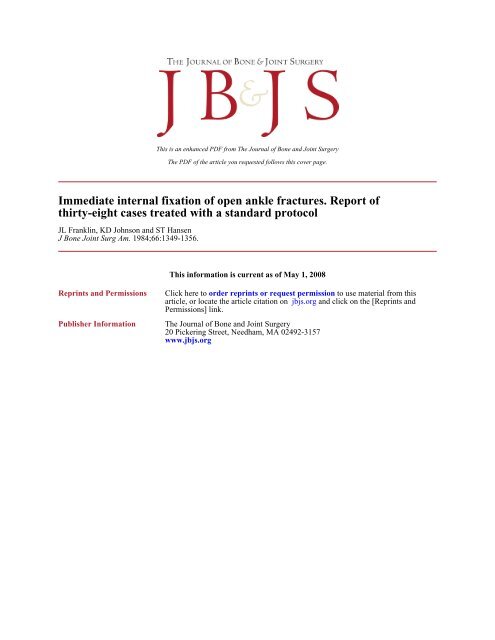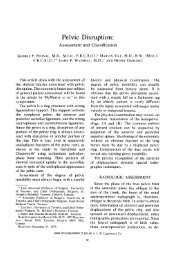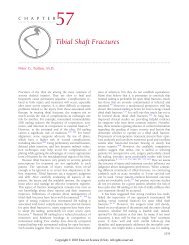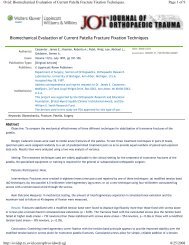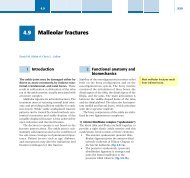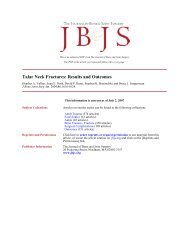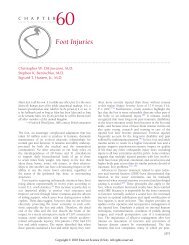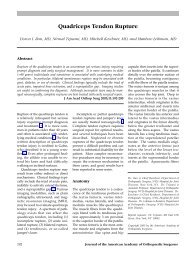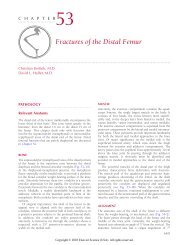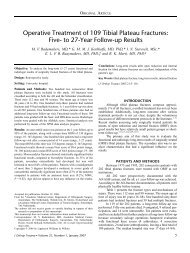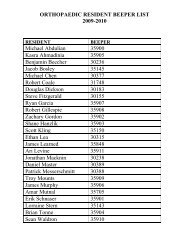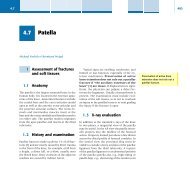Immediate internal fixation of open ankle fractures. Report
Immediate internal fixation of open ankle fractures. Report
Immediate internal fixation of open ankle fractures. Report
- No tags were found...
Create successful ePaper yourself
Turn your PDF publications into a flip-book with our unique Google optimized e-Paper software.
This is an enhanced PDF from The Journal <strong>of</strong> Bone and Joint SurgeryThe PDF <strong>of</strong> the article you requested follows this cover page.<strong>Immediate</strong> <strong>internal</strong> <strong>fixation</strong> <strong>of</strong> <strong>open</strong> <strong>ankle</strong> <strong>fractures</strong>. <strong>Report</strong> <strong>of</strong>thirty-eight cases treated with a standard protocolJL Franklin, KD Johnson and ST HansenJ Bone Joint Surg Am. 1984;66:1349-1356.This information is current as <strong>of</strong> May 1, 2008Reprints and PermissionsPublisher InformationClick here to order reprints or request permission to use material from thisarticle, or locate the article citation on jbjs.org and click on the [Reprints andPermissions] link.The Journal <strong>of</strong> Bone and Joint Surgery20 Pickering Street, Needham, MA 02492-3157www.jbjs.org
Copyright 1984 by The Journal <strong>of</strong> Bone and Joint Surgery. incorporated<strong>Immediate</strong> Internal Fixation <strong>of</strong> Open Ankle FracturesREPORT OF THIRTY-EIGHT CASES TREATED WITH A STANDARD PROTOCOLBY JONATHAN L. FRANKLIN, M.D.*, KENNETH D. JOHNSON, M.D.t, AND SIGVARD T. HANSEN, JR. , M.D.*,SEATTLE,WASHINGTONFrom the Harbort’iew Medical Center, SeaitleABSTRACT: We reviewed thirty-eight cases <strong>of</strong> <strong>open</strong><strong>ankle</strong> <strong>fractures</strong> that had been treated with a standardprotocol: alignment and splinting <strong>of</strong> the fracture at thescene <strong>of</strong> injury if possible, antibiotics administered inthe emergency room and continued for forty-eight hours,admission <strong>of</strong> the patient to the operating room as quicklyas possible, copious irrigation and thorough d#{233}bridement<strong>of</strong> the wound, immediate rigid anatomical <strong>internal</strong><strong>fixation</strong>, and delayed primary closure at five days. All<strong>of</strong> the <strong>fractures</strong> united, but three patients required subsequent<strong>ankle</strong> fusion because <strong>of</strong> cartilage damage notedat the initial operation. Of the thirty-five <strong>ankle</strong>s withcomplete follow-up, the functional result was excellentin twenty-six and fair or poor in nine.A protocol <strong>of</strong> immediate rigid <strong>internal</strong> <strong>fixation</strong> anddelayed primary closure for <strong>open</strong> <strong>fractures</strong> <strong>of</strong> the femur andtibia was instituted in 1972 at Harborview Medical Center,a regional trauma center. Use <strong>of</strong> the protocol. with its subsequentrefinements, produced excellent results with fewcomplications, and a very low infection nate7’52#{176}313436. In1976, under the guidance <strong>of</strong> one <strong>of</strong> us (S. T. H. , Jr.), theprotocol was extended to <strong>open</strong> <strong>ankle</strong> <strong>fractures</strong>, on the principlethat immediate anatomical <strong>internal</strong> <strong>fixation</strong> enhancess<strong>of</strong>t-tissue healing and produces a better functional jointwithout increasing the incidence <strong>of</strong> infection. To assess thevalidity <strong>of</strong> the protocol with regard to anatomical reduction,ultimate function <strong>of</strong> the <strong>ankle</strong>, and infection rate, we havereviewed our cases.Materials and MethodsFrom 1976 to 1981, immediate <strong>internal</strong> <strong>fixation</strong> wasperformed on all <strong>open</strong> <strong>ankle</strong> <strong>fractures</strong> at the HanborviewMedical Center. There were forty-two such <strong>fractures</strong> inforty-one consecutive patients. These were treated accordingto the following protocol.paramedical1 . The fracture is aligned and splinted in the field bypersonnel.2. Administration <strong>of</strong> an intravenous antibiotic (abroad-spectrum cephalosponin) is begun in the emergencyroom and is continued for forty-eight hours.* Division <strong>of</strong>Orthopedic Surgery. University <strong>of</strong>Texas Health ScienceCenter at Dallas. Dallas. Texas 75235.1- Department <strong>of</strong> Orthopaedics. RK-I0. University <strong>of</strong> WashinglonSchool <strong>of</strong> Medicine. Seattle, Washington 98195.3. The patient is admitted to the operating room asquickly as possible.4. All wounds are copiously irrigated and thoroughlydebrided in the operating room.5. Internal <strong>fixation</strong> is applied according to well knownprinciples2426 to provide rigid anatomical <strong>fixation</strong> with mmimum<strong>internal</strong>-<strong>fixation</strong> apparatus.6. Delayed primary closure is performed five days afterward.There were twenty-eight men and thirteen women, andthe patients ranged in age from eighteen to seventy-threeyears (median, twenty-eight years). Eighteen patients hadinvolvement <strong>of</strong> the left <strong>ankle</strong>; twenty-two, <strong>of</strong>the right <strong>ankle</strong>;and one had injuries to both <strong>ankle</strong>s.Automobile accidents (fourteen) and motorcycle accidents(twelve) were the cause <strong>of</strong> injury in about 60 percent <strong>of</strong> the patients. The other injuries resulted from fallsat ground level (five), falls from heights (four), and otheraccidents(seven).The totality <strong>of</strong> the patients’ injuries can be assessedfrom Table I. Twenty-five patients had multiple <strong>fractures</strong>;seventeen had associated disruption <strong>of</strong> ligaments, muscles.tendons. major arteries, on major nerves; and seven (Cases1 , 6, 22, 23, 28, 29, and 39) had significant head injuries.There were twenty-four bimalleolan, eight tnimalleolar, fiveisolated lateral malleolan, three isolated medial malleolar,and two pilon-type injuries. The Weber classification” for<strong>ankle</strong> <strong>fractures</strong> was not used because most <strong>of</strong> the lesionsinvolved a direct crush injury from external forces, a type<strong>of</strong> injury not described in that classification. S<strong>of</strong>t-tissue injurywas categorized in twelve lesions as grade I (a smallpuncture wound with one centimeter <strong>of</strong> peniosteal strippingon less), in fourteen as grade II (one to three centimeters <strong>of</strong>periosteal stripping without gross contamination), and insixteen as grade Ill (more than three centimeters <strong>of</strong> periostealstripping and gross contamination).Harborview Medical Center is a level-I trauma center’7,well equipped to handle immediate <strong>fixation</strong> <strong>of</strong><strong>open</strong> <strong>fractures</strong>(within twenty-four hours <strong>of</strong> the patient’s admission).Twenty-eight <strong>of</strong> the patients in the series were in the operatingroom within five hours after injury. For only onepatient was the delay longer than ten hours, and that delaywas secondary to a severe head injury.Fracture <strong>fixation</strong> was achieved with well describedtechniques and instrumentation242. In general, the fractureVOL. 66-A, NO. 9. [)ECEMBER 984 I349
IMMEDIATE INTERNAL FIXATION OF OPEN ANKLE FRACTURES I 351FIG.Figs. I-C and l-D: The reduction was maintained six months postoperatively.I-Cduration <strong>of</strong> cast immobilization averaged eleven weeks.ResultsAdequate follow-up information was obtained forthirty-seven <strong>of</strong> the forty-one patients (thirty-eight <strong>of</strong> theforty-two <strong>fractures</strong>). The follow-up ranged from thirteen tosixty-six months (median, thirty-nine months). Two patients(Cases 13 and 28) were lost from the series because <strong>of</strong> n<strong>of</strong>ollow-up. Additionally one patient (Case 6) with a brainstemcontusion and bilateral pneumonia died thirteen daysafter injury, and one patient (Case 41 ) with a severe deglovinginjury and multiple foot <strong>fractures</strong> required a belowthe-kneeamputation eleven days after injury.One <strong>of</strong> us (J. L. F.) examined twenty-four <strong>of</strong> the patientsat follow-up and interviewed eleven more by telephone.All <strong>of</strong> the patients who were interviewed bytelephone had had prior follow-up. either in the Harborviewclinic until the fracture had healed or in the <strong>of</strong>fices <strong>of</strong> privatephysicians whose records were available to us. One patientwho was included (Case 9) had been followed closely fortwo years in the orthopaedic clinic before being lost t<strong>of</strong>ollow-up, and another patient (Case 16) was followedclosely for four years before he died <strong>of</strong> unrelated causes.The patients were evaluated clinically for function,range <strong>of</strong> motion, cosmetic result, and residual pain. Roentgenogramswere evaluated for initial displacement, operativereduction, final result. and evidence <strong>of</strong> post-traumaticarthritis. Follow-up data in most categories were obtainedfor thirty-seven patients (thirty-eight <strong>ankle</strong>s). Each categoryin Table I contains only the number <strong>of</strong> patients for whomaccurate data could be obtained.VOL. 66-A, NO. 9, DECEMBER 1984
IMMEDIATE INTERNAL FIXATION OF OPEN ANKLE FRACTURES 1353The patients and their physicians rated function as follows:excellent - without limitation, good - able to jogbut some limitation <strong>of</strong> athletic participation, fair - able toperform daily activities but unable to jog, and poor - limitedduring daily activities. Only nine <strong>of</strong> thirty-five patientsrated the result as fair or poor. There was no apparentcorrelation between functional rating and type <strong>of</strong> fracture,grade <strong>of</strong> s<strong>of</strong>t-tissue injury, pain, or post-traumatic arthritis.About 70 per cent (nineteen) <strong>of</strong> the twenty-eight patientswho had been employed before injury returned to theirprevious work within six months. Of the nine patients whowere unable to do so, five had other injuries that preventedtheir return to work. The median time to walking with partialweight-bearing (thirty-nine patients) was seven weeks(range, two to forty-eight weeks). The time to full weightbearing(thirty-six patients) ranged from six to fifty-twoweeks (median, twelve weeks).Three patients (Cases 14, 39, and 40) had significantlimitation <strong>of</strong> range <strong>of</strong> motion <strong>of</strong> the <strong>ankle</strong> (less than -5degrees <strong>of</strong> extension); two <strong>of</strong> them had an associated nervepalsy and the third had severe damage to the ipsilateral kneeand the proximal part <strong>of</strong> the tibia. Despite these limitations<strong>of</strong> range <strong>of</strong> motion, only one patient rated the function <strong>of</strong>the <strong>ankle</strong> as fair rather than good. Eleven patients had lessimportant limitations <strong>of</strong> range <strong>of</strong> motion (from + 5 to -5degrees <strong>of</strong> extension) and nineteen had no limitation (morethan + 5 degrees <strong>of</strong> extension).The patients and physicians rated the final cosmeticresult as excellent (scars hardly visible), good (injury notvisible when patient wears a nylon stocking), fair (injuryvisible through a nylon stocking but without gross defonmity).or poor (gross deformity and scarring). Only four <strong>of</strong>thirty-five <strong>ankle</strong>s were rated as a fair result, despite theseverity <strong>of</strong> the initial injury; the others were good or excellent.Of the <strong>ankle</strong>s with a fair rating, two had had agrade-Il fracture and two, a grade-Ill fracture. No <strong>ankle</strong>was given a poor result rating.Nineteen patients reported no pain while six patientsreported moderate pain (occasional pain that limited activity).Three <strong>of</strong> the six patients with moderate pain were thosein whom a superficial infection developed. Three <strong>of</strong> the sixalso had evidence <strong>of</strong> post-traumatic arthritis (Table I).We reviewed the roentgenograms that had been madewhen the patient arrived at Harborview Medical Center,immediately after operation, at the time <strong>of</strong> bone-healing,and at follow-up examination. The original displacementwas classified according to the distance from the <strong>ankle</strong> mortiseto the talus: minimum displacement (seven <strong>ankle</strong>s) -less than one centimeter; moderate (twenty-two <strong>ankle</strong>s) -one to two centimeters; marked (six <strong>ankle</strong>s) - two to threecentimeters; and gross displacement (seven <strong>ankle</strong>s) - morethan three centimeters. It is likely that many <strong>of</strong> the <strong>fractures</strong>had been more severely displaced before they were alignedand splinted by paramedics at the scene <strong>of</strong> the accident.The surgical reduction. evaluated on immediate postoperativenoentgenognams. was rated as follows: anatomicalreduction (fracture lines not visible), nearly anatomical reduction(fracture lines visible but <strong>ankle</strong> mortise apparentlyanatomical), minimum displacement (one to three millimeters<strong>of</strong> mortise misalignment), and moderate displacement(three to five millimeters <strong>of</strong> mortise misalignment).Ninety-five per cent (forty) <strong>of</strong> the forty-two <strong>ankle</strong>s had anatomicalor nearly anatomical reduction immediately afteroperation, and two <strong>ankle</strong>s had minimum displacement. Posttraumaticarthritis developed in both <strong>of</strong> these <strong>ankle</strong>s.The time to roentgenographic evidence <strong>of</strong> healing, determinedby the disappearance <strong>of</strong> fracture lines and by callusformation, ranged from seven to sixteen weeks (median,9.5 weeks). The final reduction showed minimum displacementin only three <strong>of</strong> thirty-eight <strong>ankle</strong>s.Roentgenograms made after healing were examined forevidence <strong>of</strong> post-traumatic arthritis. Slight spurring or narrowing<strong>of</strong> the joint space was noted in thirteen <strong>ankle</strong>s, three<strong>of</strong> which (Cases 18, 3 1 , and 33) required fusion. The mcidence<strong>of</strong> post-traumatic arthritis was fairly well distributedamong all grades <strong>of</strong> injury (three <strong>ankle</strong>s with a grade-I, fivewith a grade-I!, and five with a grade-Ill lesion) (Table I).There were only two superficial infections in the group withpost-traumatic arthritis, which was essentially the same incidence<strong>of</strong> infection as that in the remainder <strong>of</strong> the <strong>ankle</strong>s.In the three <strong>ankle</strong>s that required fusion, significant cartilagedamage was noted at the initial <strong>open</strong> reduction. Anatomical<strong>fixation</strong> despite the cartilage injury facilitated subsequentaccurate fusion. Compared with the other twenty-four <strong>ankle</strong>s,the thirteen with roentgenographic evidence <strong>of</strong> posttraumaticarthritis had a more limited range <strong>of</strong> motion, apoorer functional rating, and a higher incidence <strong>of</strong> pain(TableI).There was only one possible deep infection (Case 9).This case was that <strong>of</strong> a nineteen-year-old man who sustaineda grade-I trimalleolar fracture when he jumped from a freewaybridge overpass. He was seen at follow-up three andone-half months after injury, complaining <strong>of</strong> pain and increasedswelling in the <strong>ankle</strong>. Roentgenograms revealed thatthe distalmost cancellous screw had migrated into the <strong>ankle</strong>joint, and therefore the screw was removed. At the time nopurulent material could be aspirated from the screw-hole,but Enterobacter cloacae grew on cultures. One week laterthe patient was progressing well clinically, and the decisionwas made not to treat him with antibiotics. He was followedfor two years, with no further evidence <strong>of</strong> infection.There were five superficial infections: four in patientswith grade-I! s<strong>of</strong>t-tissue injury and one in a patient withgrade-Il! injury. Two <strong>of</strong> these <strong>ankle</strong>s required a furtherd#{233}bnidement procedure . None required skin-grafting, andnone presented long-term problems.There were no non-unions in this series. There weretwo delayed unions, both <strong>of</strong> which required bone-grafting.In one <strong>of</strong> these patients (Case 3 1 , one <strong>of</strong> the three that hada fusion) a spontaneous fusion <strong>of</strong> the <strong>ankle</strong> in good positioneventually developed. The other patient (Case 27) had anexcellent functional result, with no pain or evidence <strong>of</strong> posttraumaticarthritis. In one patient (Case 24) a post-traumaticsympathetic dystrophy resolved with appropriate physicalVOL. 66-A, NO. 9. DECEMBER 1984
1354 J. L. FRANKLIN, K. D. JOHNSON, AND S. T. HANSEN, JR.FIG. 2-AFigs. 2-A through 2-D: Case 18. This twenty-nine-year-old man sustained a grossly displaced bimalleolar fracture.Fig. 2-A: Roentgenograms made immediately after injury.FIG. 2-B FIG. 2-C FIG. 2-DFigs. 2-B and 2-C: Significant cartilage damage was noted at surgery. Anatomical reduction was achieved and was well maintained at eleven weeks.when these roentgenograms were made and the syndesmosis screw was retiioved.Fig. 2-D: Post-traumatic arthritis is evident on this roentgenogram. made three years after injury. Ankle fusion was eventually required.therapy. One patient (Case 41). with a severe s<strong>of</strong>t-tissue tunes began in the l9405929. Over the next three decades,injury and multiple <strong>fractures</strong> in the foot, required a below- with the development <strong>of</strong> antibiotics, advancements in metthe-kneeamputation. allurgy, and improvements in surgical technique, improved. . results were reported in most investigations <strong>of</strong> <strong>open</strong>Discussion fnactures65’#{176}’2’4’6223235. Refinement in the devices avail-The widespread use <strong>of</strong> <strong>internal</strong> <strong>fixation</strong> for <strong>open</strong> frac- able for <strong>internal</strong> <strong>fixation</strong> in the 1970’s appeared to furtherTHE JOURNAL OF BONE AND JOINT SURGERY
IMMEDIATE INTERNAL FIXATION OF OPEN ANKLE FRACTURES 1355enhance the results, and the stability then provided by <strong>internal</strong><strong>fixation</strong> was believed to diminish the incidence <strong>of</strong>infection and promote healing <strong>of</strong> the injured s<strong>of</strong>t tissues24323.The improvement in results <strong>of</strong> <strong>internal</strong> <strong>fixation</strong> in <strong>open</strong><strong>fractures</strong> <strong>of</strong> the <strong>ankle</strong> are difficult to quantitate because noseries comprised exclusively <strong>of</strong> <strong>ankle</strong> <strong>fractures</strong> has beenreported in the literature, and the studies <strong>of</strong> <strong>open</strong> <strong>fractures</strong>in general, even in recent years, have included only smallnumbers <strong>of</strong> <strong>ankle</strong> <strong>fractures</strong>.In 1972, Ketenjian and Shelton reviewed fifty-five <strong>open</strong><strong>fractures</strong> that had been treated with <strong>internal</strong> <strong>fixation</strong>, includingeighteen <strong>ankle</strong> <strong>fractures</strong>’9. The infection rate overallwas 7.5 percent, but no infections occurred in the <strong>ankle</strong>s,and no <strong>ankle</strong> had a non-union, an amputation, or chronicosteomyelitis.In a review <strong>of</strong> ninety-one <strong>open</strong> <strong>fractures</strong>, only one <strong>of</strong>them affecting the <strong>ankle</strong>, Varma and Rao reported in 1974that the incidence <strong>of</strong> deep infection was higher in thosetreated non-operatively (22.6 per cent, on twelve <strong>of</strong> fiftythree<strong>fractures</strong>) than in those treated with primary <strong>internal</strong><strong>fixation</strong> (13. 1 per cent, or five <strong>of</strong>thirty-eight)3#{176}. In 1979, inthe series <strong>of</strong> Rittmann et al. there were 214 <strong>open</strong> <strong>fractures</strong>(including eight malleolan <strong>fractures</strong>), all but nine <strong>of</strong> whichwere treated with <strong>internal</strong> <strong>fixation</strong>27. The oven-all rate <strong>of</strong>osteomyelitis was 7 pen cent (with no infection in the malleolar<strong>fractures</strong>), but eight (26 per cent) <strong>of</strong> thirty-one <strong>fractures</strong>with grade-Ill s<strong>of</strong>t-tissue injury had an infection. Alsoin 1979, Chapman and Mahoney reported on ninety-four<strong>open</strong> <strong>fractures</strong>, thirty <strong>of</strong> them involving the ankl&. Therewere varying degrees <strong>of</strong> s<strong>of</strong>t-tissue involvement, and theinfection rate was low in lesions with grade-I or II injurythat were treated with primary <strong>internal</strong> <strong>fixation</strong>, but washigh (41 pen cent) in the grade-Ill injuries. In the <strong>ankle</strong>s.there were no infections in eighteen with grade-I s<strong>of</strong>t-tissueinjury, but one <strong>of</strong> nine with grade-li injury and all threewith grade-I!! injury became infected.We attribute the low incidence <strong>of</strong> infections in our ownseries, especially in <strong>ankle</strong>s with grade-Ill s<strong>of</strong>t-tissue injury,to several parts <strong>of</strong> our protocol: the use <strong>of</strong> prophylacticantibiotics beginning in the emergency room, immediateand thorough d#{233}bridement, early reduction and stabilization<strong>of</strong> the <strong>fractures</strong> with modern techniques and implants, ands<strong>of</strong>t-tissue management by delayed primary skin closure andthe use <strong>of</strong> skin grafts when necessary. The fact that theprotocol for <strong>open</strong> <strong>ankle</strong> <strong>fractures</strong> that we established wasadhered to by the entire orthopaedic staffcontnibuted greatlyto minimizing infection.We strongly believe that the early stabilization <strong>of</strong> thefracture fragments maximizes the ability <strong>of</strong> the s<strong>of</strong>t tissuesto resist infection and to heal, so that optimum functionalresults can be obtained. A recent review article on <strong>open</strong><strong>fractures</strong> by Allgower and Bonder emphasized this importantconcept’ . Three-quarters <strong>of</strong> the <strong>ankle</strong>s in our series had agood on excellent functional result, and there were no nonunionson residual infections.We believe that all <strong>of</strong> the elements <strong>of</strong> our protocolcontributed to the excellence <strong>of</strong> these results. It should benoted that standard, well accepted principles are inherent inthe protocol and then are applied to <strong>open</strong> <strong>fractures</strong> aboutthe <strong>ankle</strong>, as adapted to the local anatomical lesion. Theuse <strong>of</strong>delayed primary closure, in accordance with Halsted’steachings, is an example <strong>of</strong> how dead space and tension inthe wound are avoided. Furthermore, our initial routines <strong>of</strong>wound care and rapid admission to the operating room mmimizeddamage to the blood supply to the skin and others<strong>of</strong>t tissues and prevented further bacterial colonization <strong>of</strong>thewound.Although rapid admission to the operating room is encouragedin our protocol, including the use <strong>of</strong> <strong>internal</strong><strong>fixation</strong> and delayed primary closure, the protocol may beapplied to patients who are seen later than twelve hours afterinjury, especially if the wound had been protected and wellcleaned. However, our series included only one fracture thatwas treated late (ten hours after injury).In other reported series, the more severe the injury tothe s<strong>of</strong>t tissues the higher the infection rate was52732, butno such correlation was evident in our series. Although ourseries included sixteen grade-Ill injuries, the one (possible)deep infection occurred in an <strong>ankle</strong> with a grade-I injury.The low infection rate may have been due in part to thelocation <strong>of</strong> the <strong>fractures</strong> in metaphyseal bone. The ampleblood supply <strong>of</strong> this cancellous bone may make it moreresistant to infection than cortical bone is.The three <strong>ankle</strong>s that eventually required fusion werenoted at surgery to have significant articular-cartilage damage.It is likely that the thirteen <strong>ankle</strong>s with post-traumaticarthritic changes also had an important injury to the articularcartilage, even though this damage was not specificallynoted at surgery. Cartilage injury and inadequate reduction<strong>of</strong> the fracture therefore appear to be the important causes<strong>of</strong> post-traumatic arthritis.We believe that stable <strong>internal</strong> <strong>fixation</strong> after accuratereduction , as was achieved in about 90 per cent <strong>of</strong> the <strong>ankle</strong>sin our series, not only was important per se in achieving asuccessful result but also permitted early walking and physiologicalmotion, which stimulate healing34”’52 and helpto avoid the complications associated with prolongedimmobilization2833.Anatomical reduction is especially important when afracture involves a joint. In the <strong>ankle</strong> anatomical reductioncan be achieved most effectively with <strong>internal</strong> <strong>fixation</strong>. Inmost acute-care facilities. more and more <strong>of</strong>ten the techniques<strong>of</strong> <strong>internal</strong> <strong>fixation</strong> are being applied in closed <strong>ankle</strong><strong>fractures</strong> to promote retention <strong>of</strong> maximum function <strong>of</strong> theinjured joint. Our series is particularly important because itdemonstrates that the principle just mentioned, and the protocolthat we have outlined, can be extended safely to <strong>open</strong><strong>fractures</strong> about the <strong>ankle</strong> and perhaps to other <strong>fractures</strong> aswell.We believe that the proper treatment <strong>of</strong> the s<strong>of</strong>t-tissueinjuries also is essential to success in all <strong>fractures</strong> that aretreated with <strong>internal</strong> <strong>fixation</strong>, but particularly in <strong>open</strong> <strong>fractures</strong>.VOL. 66-A, NO. 9. DECEMBER 1984
1356 J. L. FRANKLIN, K. D. JOHNSON, AND S. T. HANSEN, JR.References1 . ALLGOWER, MARTIN, and BORDER, J. R. : Management <strong>of</strong> Open Fractures in the Multiple Trauma Patient. World J. Surg. , 7: 88-95, 1983.2. ANDERSON, J. T., and GUSTILO, R. B.: <strong>Immediate</strong> Internal Fixation in Open Fractures. Orthop. Clin. North America, 11: 569-578, 1980.3. CHAPMAN, M. W.: The Use <strong>of</strong> <strong>Immediate</strong> Internal Fixation in Open Fractures. Orthop. Clin. North America, 11: 579-591 , 1980.4. CHAPMAN, M. W. : Management <strong>of</strong> Open Fractures and Complications. Part III. Role <strong>of</strong> Bone Stability in Open Fractures. In Instructional CourseLectures, The American Academy <strong>of</strong> Orthopaedic Surgeons. Vol. 31. pp. 75-87. St. Louis, C. V. Mosby, 1982.5. CHAPMAN, M. W. , and MAHONEY, MICHAEL: The Role <strong>of</strong> Early Internal Fixation in the Management <strong>of</strong> Open Fractures. Clin. Orthop. . 138:120-131, 1979.6. CLAFFEY, T. : Open Fractures <strong>of</strong> the Tibia. In Proceedings <strong>of</strong> the Australian Orthopaedic Association. J. Bone and Joint Surg. , 42-B(2): 407,1960.7. CLANCEY, G. J. , and HANSEN, S. T. , JR. : Open Fractures <strong>of</strong> the Tibia. A Review <strong>of</strong> One Hundred and Two Cases. J. Bone and Joint Surg..60-A: 118-122, Jan. 1978.8. COPELAND, C. X., JR., and ENNEKING, W. F.: Incidence <strong>of</strong> Osteomyelitis in Compound Fractures. Am. Surg.. 31: 156-158, 1965.9. DAVIS, A. G.: Primary Closure <strong>of</strong>Compound-Fracture Wound. with <strong>Immediate</strong> Internal Fixation. <strong>Immediate</strong> Skin Graft, and Compression Dressings.J. Bone and Joint Surg. . 30-A: 405-415, April 1948..lO. Epps, C. H. , JR. , and ADAMS. J. P.: Wound Management in Open Fractures. Am. Surg. . 27: 766-769, 1961.1 1 . FRIEDRICH, B. , and KLAUE. P.: Mechanical Stability and Post-traumatic Osteitis: An Experimental Evaluation <strong>of</strong> the Relation Between Infection<strong>of</strong> Bone and Internal Fixation. Injury. 9: 23-29. 1977.12. GRISTINA, A. G. , and ROVERE, G. D.: An in Vitro Study <strong>of</strong>the Effects <strong>of</strong> Metals Used in Internal Fixation on Bacterial Growth and Dissemination.In Proceedings <strong>of</strong> the Orthopaedic Research Society. J. Bone and Joint Surg. , 45-A: 1 104. July 1963.13. GUSTILO, R. B. . and ANDERSON. J. T.: Prevention <strong>of</strong> Infection in the Treatment <strong>of</strong> One Thousand and Twenty-five Open Fractures <strong>of</strong> Long Bones.Retrospective and Prospective Analyses. J. Bone and Joint Surg. . 58-A: 453-458, June 1976.14. HAMPTON, 0. P., JR.: Basic Principles in Management <strong>of</strong> Open Fractures. J. Am. Med. Assn., 159: 417-419, 1955.15. HANSEN, S. T. , and WINQUIST, R. A.: Closed Intramedullary Nailing <strong>of</strong> the Femur. KOntscher Technique with Reaming. Clin. Orthop. . 138: 56-61, 1979.16. HICKS, J. H.: The Relationship between Metal and Infection. Proc. Roy. Soc. Med. . 50: 842-844. 1957.17. HOSPITAL RESOURCES FOR THE OPTIMAL CARE OF THE INJURED PATIENT: Bull. Am. Coil. Surg. , 64(9): 43-48, 1979.18. HUGHES, J. L. ; WEBER, H. ; WILLENEGGER, H.; and KUNER, E. H. : Evaluation <strong>of</strong> Ankle Fractures: Non-Operative and Operative Treatment.Clin. Orthop., 138: 111-119, 1979.19. KETENJIAN, A. Y. , and SHELTON, M. L. : Primary Internal Fixation <strong>of</strong> Open Fractures: A Retrospective Study <strong>of</strong> the Use <strong>of</strong> Metallic InternalFixation in Fresh Open Fractures. J. Trauma, 12: 756-763, 1972.20. KIRBY, R. M.; WINQUIST, R. A. ; and HANSEN, S. T. . JR.: Femoral Shaft Fractures in Adolescents: A Comparison Between Traction. plus CastTreatment and Closed Intramedullary Nailing. J. Pediat. Orthop.. 1: 193-197, 1981.21 . LADUCA, J. N. ; BONE, L. L. ; SEIBEL, R. W. ; and BORDER. J. R. : Primary Open Reduction and Internal Fixation <strong>of</strong> Open Fractures. J. Trauma,20: 580-586, 1980.22. LOTTES, J. 0. ; HILL, L. J. ; and KEY, J. A. : Closed Reduction, Plate Fixation, and Medullary Nailing <strong>of</strong> Fractures <strong>of</strong> Both Bones <strong>of</strong> the Leg. AComparative End-Result Study. J. Bone and Joint Surg. , 34-A: 861-877. Oct. 1952.23. MCNEUR, J. C. : The Management <strong>of</strong> Open Skeletal Trauma with Particular Reference to Internal Fixation. J. Bone and Joint Surg. , 52-B(1): 54-60, 1970.24. MAST, J. W. , and TEIPNER, W. A. : A Reproducible Approach to the Internal Fixation <strong>of</strong> Adult Ankle Fractures: Rationale, Technique, and EarlyResults. Orthop. Clin. North America, 11: 661-679. 1980.25. MULLER, M. E. ; ALLGOWER, M. ; and WILLENEGER, H. : Manual <strong>of</strong> Internal Fixation. Technique Recommended by the AO-Group. New York,Springer, 1970.26. MULLER, M. E. ; ALLGOWER, M. ; SCHNEIDER, R. ; and WILLENEGER, H.: Manual <strong>of</strong> Internal Fixation. Technique Recommended by the AO-Group.Ed. 2, pp. 282-299. New York, Springer, 1979.27. RITTMANN, W, W. ; SCHIBLI, M. : MATTER, P. ; and ALLGOWER, M.: Open Fractures: Long-Term Results in 200 Consecutive Cases. Clin. Orthop.,138: 132-140, 1979.28. SARMIENTO, AUGUSTO; SCHAEFFER, J. F. ; BECKERMAN, LINDA; LATTA, L. L. ; and ENIS, J. E. : Fracture Healing in Rat Femora as Affected byFunctional Weight-Bearing. J. Bone and Joint Surg. , 59-A: 369-375, April 1977.29. 5010-HALL, RALPH, and H0RwITz, THOMAS: The Treatment <strong>of</strong> Compound Fractures <strong>of</strong> the Femur. J. Am. Med. Assn. , 130: 128-134, 1946.30. VARMA, B. P. , and RAO, Y. P. C. : An Evaluation <strong>of</strong> the Results <strong>of</strong> Primary Internal Fixation in the Treatment <strong>of</strong> Open Fractures. Injury, 6: 22-27, 1974.31. VEITH, R. G.; WINQUIST, R. A.; and HANSEN, S. T., JR.: Ipsilateral Fractures <strong>of</strong> the Femur and Tibia. A <strong>Report</strong> <strong>of</strong> Fifty-seven ConsecutiveCases. J. Bone and Joint Surg. , 66-A: 991-1002, Sept. 1984.32. VELISKAKIS, K. P.: Primary Internal Fixation in Open Fractures <strong>of</strong> the Tibial Shaft. The Problem <strong>of</strong> Wound Healing. J. Bone and Joint Surg.,41-B(2): 342-354, 1959.33. WEBB, J. K.: The Orthopedic Management and Rehabilitation <strong>of</strong> Patients with Multiple Skeletal Injuries. Orthop. Clin. North America, 9: 569-579, 1978.34. WINQUIST, R. A. , and HANSEN, S. T. , JR. : Segmental Fractures <strong>of</strong> the Femur Treated by Closed Intramedullary Nailing. J. Bone and Joint Surg.,60-A: 934-939, Oct. 1978.35. WINQuIsT, R. A. , and HANSEN, S. T. , JR. : Comminuted Fractures <strong>of</strong> the Femoral Shaft Treated by Intramedullary Nailing. Orthop. Clin. NorthAmerica, 11: 633-648, 1980.36. WINQUIST, R. A. ; HANSEN, S. T. , JR. ; and CLAWSON, D. K. : Closed Intramedullary Nailing <strong>of</strong> Femoral Fractures. A <strong>Report</strong> <strong>of</strong> Five Hundredand Twenty Cases. J. Bone and Joint Surg. , 66-A: 529-539, April 1984.37. YABLON, I. G. ; HELLER, F. G. ; and SHOUSE, LEROY: The Key Role <strong>of</strong> the Lateral Malleolus in Displaced Fractures <strong>of</strong> the Ankle. J. Bone andJoint Surg. , 59-A: 169-173, March 1977.38. ZADIK, F. R. : Primary Internal Fixation <strong>of</strong> Compound Fractures. In Proceedings <strong>of</strong> the British Orthopaedic Association. J. Bone and Joint Surg.,35-B(1): 146-147, 1953.THE JOURNAL OF BONE AND JOINT SURGERY


